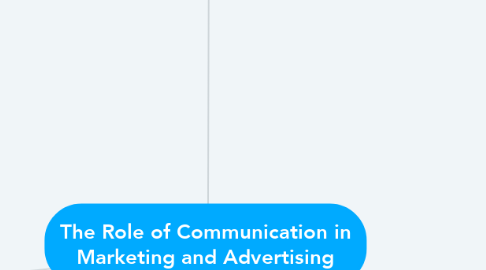
1. Communication
1.1. Communication is simply the act of transferring information from one place, person or group to another.
1.2. Categories of Communication
1.2.1. Verbal communication
1.2.1.1. Face-to-Face
1.2.1.2. Telephone
1.2.1.3. Radio
1.2.1.4. Television
1.2.1.5. Other Media
1.2.2. Non-verbal communication
1.2.2.1. Body Language
1.2.2.2. Gestures
1.2.2.3. Clothes we wear
1.2.3. Written Communication
1.2.3.1. Letter
1.2.3.2. Email
1.2.3.3. Social Media
1.2.3.4. Books
1.2.3.5. Magazines
1.2.3.6. The Internet
1.2.4. Visualization
1.2.4.1. Graphs
1.2.4.2. Charts
1.2.4.3. Maps
1.2.4.4. Logos
2. ADVERTISING
2.1. Advertising is a marketing tactic involving paying for space to promote a product, service, or cause. The actual promotional messages are called advertisements, or ads for short. The goal of advertising is to reach people most likely to be willing to pay for a company’s products or services and entice them to buy.
2.2. CATEGORIES OF ADVERTISING
2.2.1. DIsplay Ads
2.2.1.1. Mostly done on the Internet
2.2.1.2. Text Ads
2.2.1.3. Floating Banner on a specific Domain Website
2.2.2. Social Media Ads
2.2.2.1. Instagram
2.2.2.2. Facebook
2.2.2.3. Pinterest
2.2.2.4. Twitter
2.2.3. Newspaper & Magazines
2.2.3.1. Traditional
2.2.4. Outdoor Advertising
2.2.4.1. Buses
2.2.4.2. Taxis
2.2.4.3. Pedicabs
2.2.4.4. Bike Messengers
2.2.5. Radio & Podcasts
2.2.5.1. Subscribers of the Radio or Podcasts will remember your Ad
2.2.5.2. Change of Sponsorship
2.2.6. Direct Mail
2.2.6.1. If effective, customers would recommend or refer your product
2.2.7. Video Ads
2.2.7.1. Youtube
2.2.7.2. Hulu
2.2.7.3. Blogs
2.2.8. Product Placement
2.2.8.1. Feature to be on a Youtube Video
2.2.8.2. A movie
2.2.9. Event Marketing
2.2.9.1. Sponsor a team
2.2.9.2. Sponsor a charity
2.2.9.3. Achieving large amount of potential customers on hearing about the company or product and services
2.2.10. Email Marketing
2.2.10.1. Focusing on existing customers
2.2.10.2. Promotional sales or newsletter
2.3. ADVERTISING COMMUNICATION
2.3.1. Advertising is the broad and direct communication that introduces your brand to the public, educates about your products and services, prompts people with an interest to take action and provides urgency when you convey special promotions.
2.3.2. OBJECTIVES OF ADVERTISING COMMUNICATION
2.3.2.1. Branding
2.3.2.1.1. Introduce a brand to new market
2.3.2.1.2. Colors
2.3.2.1.3. Shapes
2.3.2.1.4. Slogans
2.3.2.1.5. Sensory Triggers
2.3.2.2. Education
2.3.2.2.1. Introduces Product
2.3.2.2.2. Conveys the product's indofrmation
2.3.2.3. Call to Action
2.3.2.3.1. Provoke Immediate Response
2.3.2.3.2. Induce a viewer
2.3.2.3.3. Reader
2.3.2.4. Urgency
2.3.2.4.1. Special Promotion Create Ugrency
2.3.2.4.2. Coupons
3. MARKETING
3.1. Marketing is the link between a society's material requirements and its economic patterns of response. Marketing satisfies these needs and wants through exchange processes and building long term relationships.
3.2. TYPES OF MARKETING STRATEGIES
3.2.1. Paid Advertising
3.2.1.1. Print Media
3.2.1.2. TVc's
3.2.1.3. Internet Marketing
3.2.2. Cause Marketing
3.2.2.1. Company Awareness
3.2.2.2. Social Cause or Issue
3.2.3. Relationship Marketing
3.2.3.1. Customer Building
3.2.3.2. Customer Loyalty
3.2.4. Undercover Marketing
3.2.4.1. Stealth Marketing
3.2.4.2. Customers are unaware of the marketing strategy
3.2.5. Word of Mouth
3.2.5.1. Impression left on people
3.2.5.2. Quality Services = Customer Satisfaction = Free Promotion
3.2.6. Internet Marketing
3.2.6.1. Cloud Marketing
3.2.6.2. Promotion in various Platforms
3.3. MARKETING COMMUNICATION
3.3.1. MarCom can be described as all the messages and media you deploy to communicate with the market.
3.3.2. PROMOTIONAL MIX
3.3.2.1. Advertising
3.3.2.1.1. Paid Form
3.3.2.1.2. Non-Personal
3.3.2.1.3. Mass Marketing Communication
3.3.2.1.4. Non-Personalised
3.3.2.1.5. Wide Audience
3.3.2.2. Sales Promotion
3.3.2.2.1. Incentives
3.3.2.2.2. Special Offers
3.3.2.2.3. Quick Boost to Sales, but affects can last for a short
3.3.2.2.4. Overuse may cause damage to the brand image of a business
3.3.2.3. Public Relations
3.3.2.3.1. Considered to be Highly Credible
3.3.2.3.2. Can result in higher relationship with the public
3.3.2.4. Personal Selling
3.3.2.4.1. Interactive
3.3.2.4.2. Leads to Sales Closure
3.3.2.4.3. Costly
3.3.2.4.4. Time Consuming
3.3.2.5. Direct Marketing
3.3.2.5.1. Direct Mail
3.3.2.5.2. Telemarketing
3.3.2.5.3. Door to Door
3.3.2.5.4. Responsive Tv
3.3.2.5.5. Internet
3.3.2.5.6. Can be personalized
3.3.2.5.7. Easily and Quickly Measured
3.3.2.6. Online Promotion
3.3.2.6.1. Digital Media Channels
3.3.2.6.2. Ability to reach Global Audiences
3.3.2.6.3. Highly Measurable
3.3.2.6.4. Interactive
3.4. INTEGRATED MARKETING COMMUNICATIONS (IMC)
3.4.1. The concept of integrated marketing communication (IMC) was introduced in the 1980s (Schultz and Schultz, p. 19) and has since changed the way communicators and marketers interact and conduct business. The American Marketing Association defines IMC as “a planning process designed to assure that all brand contacts received by a customer or prospect for a product, service, or organization are relevant to that person and consistent over time.”
3.4.2. THE TOOLS OF IMC
3.4.2.1. The Foundation
3.4.2.1.1. Bases on strategic understanding of the Product and the Market
3.4.2.1.2. Changes in Technology
3.4.2.1.3. Buyer Attitude
3.4.2.1.4. Behaviour
3.4.2.2. The Corporate Culture
3.4.2.2.1. Culture of Corporation
3.4.2.2.2. Coporation Personality
3.4.2.3. The Brand Focus
3.4.2.3.1. This is the Logo
3.4.2.3.2. Corporate Identity
3.4.2.3.3. Tagline
3.4.2.3.4. Style
3.4.2.3.5. Core Message of the Brand
3.4.2.4. Consumer Experience
3.4.2.4.1. Design of the Product
3.4.2.4.2. Packaging
3.4.2.4.3. Product Experience
3.4.2.4.4. Customer Serivce
3.4.2.5. Communication Tool
3.4.2.5.1. Includes All Modes of Advertising
3.4.2.5.2. Direct Marketing
3.4.2.5.3. Online Communication, Including Social Media
3.4.2.6. Promotional Tools
3.4.2.6.1. Trade Promotion
3.4.2.6.2. Consumer Promotions
3.4.2.6.3. Personal Selling
3.4.2.6.4. Database Marketing
3.4.2.6.5. Customer Relations Management
3.4.2.6.6. Sponsorship Programme
3.4.2.7. Integration Tools
3.4.2.7.1. A Software Tool
3.4.2.7.2. Tracking Customer Behaviour
3.4.2.7.3. Campaign Effectiveness
3.4.2.7.4. Including Customer Relationship Management (CRM)
3.4.2.7.5. Marketing Automation
3.4.2.7.6. Inbound Marketing Software
3.4.3. CHALLENGES AND BARRIERS OF IMC
3.4.3.1. Functional Silos
3.4.3.2. Stifled Creativity
3.4.3.3. Time Scaled Conflicts
3.4.3.4. Lack of Management
3.4.3.5. Flexibility / Modification Issues

